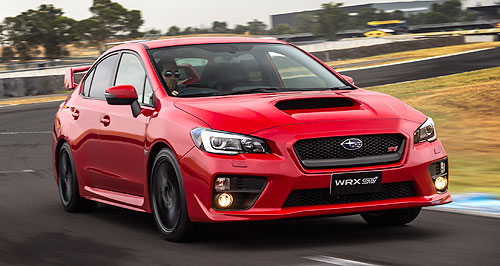Future models - Subaru - WRXNew engines considered for Subaru WRXT-WRX: Subaru’s current WRX and STI range are among the most pollutant in the small car performance market, with up to 213 grams per kilometre emitted from the manual WRX sedan. Tightening emissions forces Subaru to study new powertrains for WRX and STI12 Apr 2017 By TUNG NGUYEN in JAPAN STRICTER emissions standards are forcing Subaru to consider new powertrains for its next-generation WRX and WRX STI performance heroes, that are likely to come to market in about 2020. Speaking to GoAuto at the international first drive of the new XV in Japan, Subaru general manager of overseas sales and marketing Makoto Inoue revealed that the company was contemplating new performance engines. “This is under consideration, under discussion, but definitely I think the market tendency requires us to… achieve the boost, the power and the environmental factors,” he said. “So, in that sense, if we will be able to introduce the next-generation STI, or WRX, definitely we will have to consider to adapt some new technologies.” When launched back in 2014, the current-generation Subaru WRX introduced a new 2.0-litre turbocharged four-cylinder Boxer codenamed FA20F, which featured direct injection and a twin-scroll turbo, replacing the old 2.5-litre EJ255 unit. Power peaks at 197kW at 5600rpm, while maximum torque of 350Nm is available from 2400 to 5200rpm and the combined fuel consumption rating with a six-speed manual is 9.2 litres per 100km and 8.6L/100km in continuously variable transmission (CVT)-equipped models. Average carbon dioxide emissions however, ranges from 199 grams per kilometre in the CVT up to 213g/km for the manual – making the WRX more pollutant than higher displacement and six-cylinder engined Porsche 911 Turbo (212g/km), BMW M3 (194g/km) and Alfa Romeo Giulia QV (189g/km), as well as the 2.8-litre turbo-diesel manual Toyota HiLux SR5 double cab (201g/km). The current Aussie-spec WRX STI on the other hand, makes use of a carryover 2.5-litre turbo four codenamed EJ257 that produces 221kW at 6000rpm and 407Nm at 4000rpm. Fuel economy is rated at 10.4L/100km and CO2 emissions averages to 242g/km, making the WRX STI more of a polluter than the Mercedes-AMG GT S (219g/km) and almost as pollutant as the Toyota LandCruiser (250g/km), Ferrari California T (250g/km) and McLaren 570S (249g/km) – all of which use V8 powertrains. Japanese domestic market (JDM) WRX STIs are powered by an EJ207 2.0-litre turbo four boxer derived from the 1998 GC8 WRX. Mr Inoue indicated that potential new powertrains would have to retain the similar characteristics and performance figures for the WRX and WRX STI, and that tightening emissions standards were forcing Subaru to consider new options. Another potential for Subaru to reduce its overall fleet emissions is to introduce smaller capacity turbocharged motors across the rest of its passenger car range, which currently makes use of atmo boxer engines. “I think actually this kind of engine, the small capacity with the turbocharger, is the kind the market tends to, right?” he said. “We are now studying hard which kind of engine will have the potential to reduce some environment (impact). We are going to develop our new engine line-ups, this is true.” Specifications for Subaru’s new range of engines are still being kept a close secret, but electrification and hybridisation are also expected to factor into the brand’s future powertrain offerings. “All over the world, environmental regulations are getting tougher and tougher and as a manufacturer we have to reduce those kinds of things,” Mr Inoue said. “In the future we have to consider those kinds of things, definitely we have to consider, but actually over time we are going to introduce those kinds of electric vehicles and hybrid vehicles to the market, but we have not yet decided (when and where). “We, Subaru, are a very small manufacturer, so in order for us to introduce those types of electric vehicles we have to study a lot and then, at this moment, we can only introduce this type of mild hybrid vehicle, but definitely we have to consider a further enhanced vehicle. “It’s our only choice.”  Read more6th of January 2017  Fresh-faced Subaru WRX uncoveredStyling, technology and performance updates incoming for Subaru’s WRX rally heroAll future models Alfa Romeo Alfa Romeo Abarth Abarth Audi Audi Aston Martin Aston Martin BMW BMW Bentley Bentley Chrysler Chrysler Chevrolet Chevrolet Dodge Dodge Citroen Citroen Ferrari Ferrari DS DS Ford Ford Fiat Fiat FPV FPV Foton Foton Haval Haval Great Wall Great Wall Honda Honda Holden Holden Hyundai Hyundai HSV HSV Isuzu Isuzu Infiniti Infiniti Jeep Jeep Jaguar Jaguar Lamborghini Lamborghini Kia Kia Lexus Lexus Land Rover Land Rover Mazda Mazda Maserati Maserati Mercedes-Benz Mercedes-Benz McLaren McLaren Mini Mini Nissan Nissan Mitsubishi Mitsubishi Peugeot Peugeot Opel Opel Proton Proton Porsche Porsche Renault Renault Ram Ram Saab Saab Rolls-Royce Rolls-Royce Smart Smart Skoda Skoda Subaru Subaru SsangYong SsangYong Tesla Tesla Suzuki Suzuki Toyota Toyota Volvo VolvoWRX pricing
Motor industry news |
Click to shareSubaru modelsResearch Subaru All future models Alfa Romeo Alfa Romeo Abarth Abarth Audi Audi Aston Martin Aston Martin BMW BMW Bentley Bentley Chrysler Chrysler Chevrolet Chevrolet Dodge Dodge Citroen Citroen Ferrari Ferrari DS DS Ford Ford Fiat Fiat FPV FPV Foton Foton Haval Haval Great Wall Great Wall Honda Honda Holden Holden Hyundai Hyundai HSV HSV Isuzu Isuzu Infiniti Infiniti Jeep Jeep Jaguar Jaguar Lamborghini Lamborghini Kia Kia Lexus Lexus Land Rover Land Rover Mazda Mazda Maserati Maserati Mercedes-Benz Mercedes-Benz McLaren McLaren Mini Mini Nissan Nissan Mitsubishi Mitsubishi Peugeot Peugeot Opel Opel Proton Proton Porsche Porsche Renault Renault Ram Ram Saab Saab Rolls-Royce Rolls-Royce Smart Smart Skoda Skoda Subaru Subaru SsangYong SsangYong Tesla Tesla Suzuki Suzuki Toyota Toyota Volvo VolvoWRX pricing
Motor industry news |

















Facebook Twitter Instagram